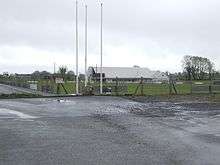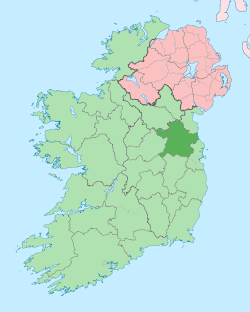Ratoath
Ratoath (Irish: Ráth Tó, meaning "Tó's ringfort")[2] is a town in the barony of the same name in County Meath, Ireland. The town is centred on the point where the R125 and R155 regional roads meet. The Broad Meadow River (Irish: An Gabhair) flows through the town. As of the 2016 census, there were 9,533 people living in Ratoath.[1]
Ratoath Ráth Tó | |
|---|---|
Town | |
 Ratoath – Holy Trinity church | |
 Ratoath Location in Ireland | |
| Coordinates: 53.506°N 6.463°W | |
| Country | Ireland |
| Province | Leinster |
| County | County Meath |
| Elevation | 90 m (300 ft) |
| Population (2016)[1] | 9,533 |
| Time zone | UTC±0 (WET) |
| • Summer (DST) | UTC+1 (IST) |
| Eircode routing key | A85 |
| Telephone area code | +353(0)1 |
| Irish Grid Reference | O016519 |
Name
Ratoath gives its name to a village, a townland, a parish, an electoral division and to a barony. The derivation or meaning of the word is uncertain. Two alternative Irish forms are cited: Ráth-Tógh and Ráth-Tábhachta. These place names occur in Irish manuscripts and scholars say that the writers were referring to Ratoath. Evidently they were trying to give a phonetic rendering of a name that was unfamiliar to them. Mruigtuaithe occurs in the Book of Armagh as the name of one of these places in Meath where Saint Patrick founded a church and Eoin MacNeill identifies it as Ratoath. If this is correct it would seem that the second portion of the word comes from the Irish word tuath which means a territory belonging to a family or sept. Mruig means a grazing plain. Ráth is the Irish for a ringfort. In a royal grant of the manor of Ratoath to Sir Robert Bold in 1468 it was described as Rathonth.
Amenities
Ratoath has its own secondary school known as Ratoath College.
Ratoath has a number pubs, shops, restaurants, and takeaways such as Ryans pub, Centra and Thai Yummy.
Population and demographics
| Historical population | ||
|---|---|---|
| Year | Pop. | ±% |
| 1991 | 593 | — |
| 1996 | 1,061 | +78.9% |
| 2002 | 3,794 | +257.6% |
| 2006 | 7,249 | +91.1% |
| 2011 | 9,043 | +24.7% |
| 2016 | 9,533 | +5.4% |
In the 20 years between the 1996 and 2016 census, the population of Ratoath increased nearly 10-fold, from 1,061 in 1996 to 9,533 by 2016.[3] According to the 2016 census report, 87% of the town's houses (2,437 of 2,790 households) were constructed between 1991 and 2010.[1]
Ratoath is a commuter town with most of its adult population commuting to Dublin to work. More than three quarters of the population travel to work by car. In 2011, 10.9% of the workforce was unemployed compared to the national average of 19%. As of 2011, social class A, employers and managers constituted 717 of the 2,751 households.[4]
In April 2011 Ratoath had a population of 9,043, consisting of 4,520 males and 4,523 females. The population of pre-school age (0–4) was 1,158, of primary school going age (5–12) was 1,582 and of secondary school going age (13–18) was 724. There were 313 persons aged 65 years and over. The number of persons aged 18 years or over was 5,677.[5] Non-Irish nationals accounted for 9.7 per cent of the population of Ratoath in 2011 compared with a national average figure of 12.0 per cent. UK nationals (168 persons) were the largest group, followed by Lithuanians (120 persons).[5] 3,676 persons could speak the Irish language and of these 1,702 spoke the language daily. 1,025 persons spoke a language other than Irish or English at home and of these 137 could not speak English well or at all. French was the most common foreign language spoken at home with 131 speakers.[5] There were 7,843 Roman Catholics in the area at census time. A further 649 were adherents of other stated religions, while 420 persons indicated that they had no religion.[5]
Sport

Just outside the town is the horse racing track Fairyhouse racecourse, where the Irish Grand National is held. Ratoath has a long history with horse racing, with many jockeys coming from the area. These include Keith Flood, the founder of Fairyhouse racecourse, and holder of the record for the most Grade 1 wins in Ireland and the UK.
In 2016, for the first time in their history, Ratoath GAA hurlers got into a Leinster final after they defeated Rosenallis.[6]
See also
References
- "Small Area Population Statistics - Settlements - Ratoath". Census 2016. Central Statistics Office. 2016.
- "Ráth Tó / Ratoath". logainm.ie. Irish Placenames Database. Retrieved 17 February 2020.
- "Ratoath (Ireland) Census Town". citypopulation.de. Retrieved 17 February 2020.
- "Settlement Ratoath (CSO Area Code ST 11005)". census.cso.ie. Central Statistics Office. 2011. Retrieved 17 February 2020.
- "Ratoath Area Profile" (PDF). Census 2011. Central Statistics Office. Retrieved 17 February 2020.
- "Extra time heartache for Rosenallis in Leinster JHC semi-final". leinsterexpress.ie. 29 November 2016. Retrieved 1 December 2016.
| Wikimedia Commons has media related to Ratoath. |
